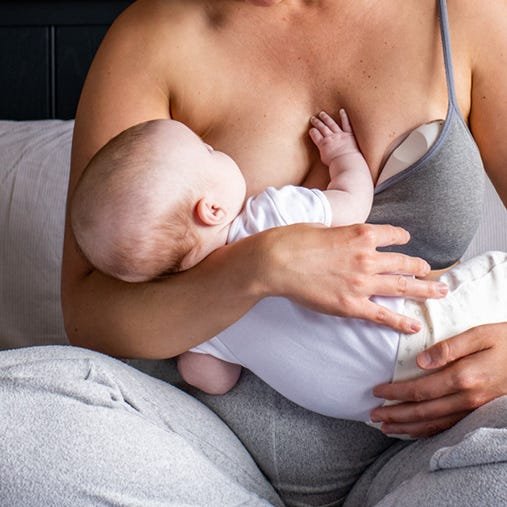If you're getting ready for your baby's arrival and preparing to breastfeed, you've probably heard whispers of 'the first latch' or 'latching on'. But you may not know exactly what a good breastfeeding latch is, or how to achieve it - after all, you're new to all this!
So, let's demystify this breastfeeding lingo, and run you through everything you need to know about latching on while breastfeeding.
What is the definition of latching on?
Latching on is the process of getting your little one to suckle around your nipple and areola so they can breastfeed comfortably.
If your baby is latched on properly, breastfeeding shouldn't cause you pain and your nipples won't become cracked or painful.
Think of your areola as a target for your baby's mouth and try to get them right in the bullseye! They should press against this target to trigger the flow of your milk and establish a good breast milk supply.
How can I make sure my baby is latching on right?
Getting the hang of a good breastfeeding latch that's comfortable for you both can be tricky at first. It can take time and perseverance to get it all going smoothly!
Don't stress, we're here to talk you through how to get a good latch with some of our top breastfeeding latching tips:
- Let baby's head tilt back and brush your nipple against their lips.
- Try and let your little one find your nipple on their own. Put them in a comfy position where the nipple is close to their mouth and gently guide them there.
- Direct your nipple slightly above their top lip, and make sure their chin is not tucked down towards their chest.
- Aim their bottom lip away from your nipple's base.
- Their lips should be turned outwards.
- They should lean into your breast with their chin first, open their mouth wide, and then latch on.
- Their chin should be firmly against your breast, with nothing against their nose.
- Baby's tongue should be able to reach as much of your breast as possible and the areola (the circular, pigmented area around your nipple) should be in their mouth as well.
- Their cheeks should look rounded as they feed with a good latch.
If you think your baby isn't latched correctly or if your nipples hurt while nursing, you can slide your finger into their mouth to break the hold they have on your breast. You can then try again and alter your position to achieve a better latch that's more comfortable.
Don't forget, it's not supposed to be painful. You and your baby should be comfortable, and you should be able to see them sucking, swallowing, and breathing.
Signs you have a good breastfeeding latch
Getting the hang of a good breastfeeding latch that's comfortable for you both can be tricky at first. It can take time and perseverance to get it all going smoothly!
There are some signs to look out for that will let you know if your baby is latched on properly:
- Their lips should be flared out against your breast and not tucked in like they're sucking on a straw. Remember, a baby's gums and tongue do most of the work, and your nipple should be deep into their mouth.
- You should be able to hear or see them suck, swallow, and breathe in a steady pattern and their chin and nose should be touching your breast, without squashing them.
- Breastfeeding shouldn't be painful if everything is going to plan. If you're experiencing pain in your breasts and especially your nipples, your baby might not be latched correctly and might be irritating your nipples.
- If your nipples are long and round after feeding, it's likely that they were able to go deep into your baby's mouth for a good feed.
- If you find that your nipple is flat or inverted, your baby may not have been able to get a good latch at that time.
Top tips for getting a correct latch on when breastfeeding
Getting a latch for bigger boobs can be more difficult so it's important to get into the right position.
Getting a good breastfeeding latch should become easier with time, but if you're finding it hard, try giving these breastfeeding latch tricks and tips a try:
- If you're struggling with getting a good latch, moving to a quiet place that you find calming can help. If you're uncomfortable or stressed, your baby probably will be too.
- Hold your baby close and try using skin-to-skin contact to comfort them if they're feeling frustrated.
- Chat or sing to your baby as they feed to soothe them.
- It'll be easier to establish a deep latch if you feed your baby when they're calm and before they get too hungry.
- Try different breastfeeding positions to find which one works best for you both.
If these tips don't help and you're still struggling to achieve a good latch or are concerned that your baby may be tongue-tied, consult your doctor or health visitor for advice.









